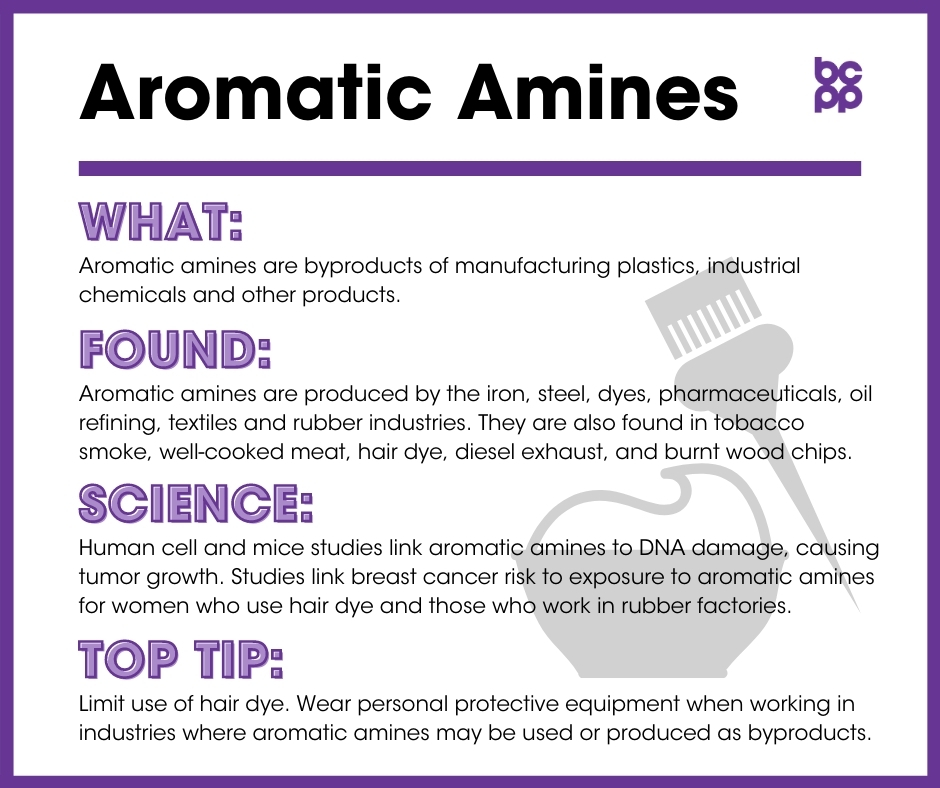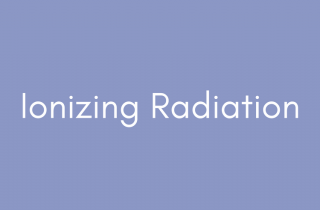Aromatic Amines
At a Glance
Aromatic amines are chemicals found in industrial and manufacturing plants, tobacco smoke, commercial hair dyes, and diesel exhaust.
Many are carcinogens and endocrine disruptors that may increase the risk of breast cancer.

What are aromatic amines?
Aromatic amines are byproducts of manufacturing plastics, industrial chemicals and other products. They can be divided into three categories and have been classified as known, probable, and possible human carcinogens by the International Agency for Research on Cancer (IARC). [1],[2],[3]
Where are aromatic amines found?
Aromatic amines are found in industries such as iron, steel, dyes, pharmaceuticals, oil refining, personal household services, textile manufacturing, leather manufacturing, and rubber.[4],[5] They are also found in tobacco smoke, well-cooked meat, hair dye and diesel exhaust and can be produced by burning wood chips.[6],[7]
What evidence links aromatic amines to breast cancer?
- Female workers at a rubber factory were exposed to aromatic amines. They subsequently had a 3.7- to 10-fold increase in breast cancer risk.[8]
- Women who used hair dyes containing aromatic amines, like 4-aminobiphenyl, had a 23 percent higher risk of developing breast cancer than women who did not use hair dyes. [9]
- DNA damage occurred in mammalian cells exposed to aromatic amines.[10] The accumulation of DNA damage can lead to cancer, including breast cancer.[11]
- Aromatic amines can form in meat cooked at high temperatures. It was found that women who often consumed this meat had an increased risk of breast cancer.[12]
- Studies using cancer cells from the human breast show that aromatic amines form structures that indicate DNA damage within the cell. Buildup of DNA damage can lead to tumor development.[13]
- A study of breast cancer cells that are sensitive to estrogen showed that some aromatic amines can mimic estrogen. This may increase the development of tumors.[14]
- Ingestion of an aromatic amine, 2-amino-1-methyl-6-phenylimidazo[4,5-b]pyridine (PhIP), led to the development of mammary tumors in mice.[15]
Who is most likely to be exposed to aromatic amines?
Tobacco smokers, women who regularly use hair dye, and employees in industries where aromatic amines may be produced are most likely to be exposed.
Who is most vulnerable to the health effects?
Women between puberty and childbirth are most vulnerable. Exposure to chemicals such as aromatic amines during this period increases the risk of women developing breast cancer later in life.[16]
What are the top tips to avoid exposure?
- Wear appropriate personal protective equipment when working in industries where aromatic amines may be used or produced as byproducts.
- Limit intake of well-cooked meats.
- Avoid burning wood chips and smoking tobacco.
- Limit contact with hair dye.
Reviewed 2019
[1] Trakoli, Anna. “IARC Monographs on the Evaluation of Carcinogenic Risks to Humans. Volume 99: Some Aromatic Amines, Organic Dyes, and Related Exposures. International Agency for Research on Cancer.” Occupational Medicine 62, 3 (2012): 232. doi:10.1093/occmed/kqs011.
[2] DeBruin, Lillian S, and P David Josephy. “Perspectives on the chemical etiology of breast cancer.” Environmental Health Perspectives 110 (2002): 119-28. doi:10.1289/ehp.02110s1119.
[3] Kizil, Mevlüde, Fatih Oz and H Tanju Besler. “A Review on the Formation of Carcinogenic/Mutagenic Heterocyclic Aromatic Amines.” Journal of Food Processing & Technology 2, 5 (2011). doi:10.4172/2157-7110.1000120.
[4] Van Tongeren, Martie, Araceli S Jimenez, Sally J Hutchings, Laura MacCalman, Lesley Rushton and John W Cherrie. “Occupational cancer in Britain.” British Journal of Cancer 107 (2012): S18-S26. doi:10.1038/bjc.2012.114.
[5] de Vocht, Frank et al. “Cancer mortality and occupational exposure to aromatic amines and inhalable aerosols in rubber tire manufacturing in Poland.” Cancer Epidemiology 33, 2 (2009): 94-102. doi:10.1016/j.canep.2009.06.013.
[6] Pereira, Luciana, Pijush Kanti Mondal and Madalena Alves. “Aromatic Amines Sources, Environmental Impact and Remediation.” In: Lichtfouse E., Schwarzbauer J., Robert D. (eds) Pollutants in Buildings, Water and Living Organisms. Environmental Chemistry for a Sustainable World 7 (2015): 297-346. doi:10.1007/978-3-319-19276-5_7.
[7] DeBruin, Lillian S, and P David Josephy. “Perspectives on the chemical etiology of breast cancer.” Environmental Health Perspectives 110 (2002): 119-28. doi:10.1289/ehp.02110s1119.
[8] de Vocht, Frank et al. “Cancer mortality and occupational exposure to aromatic amines and inhalable aerosols in rubber tire manufacturing in Poland.” Cancer Epidemiology 33, 2 (2009): 94-102. doi:10.1016/j.canep.2009.06.013.
[9] Heikkinen, Sanna et al. “Does Hair Dye Use Increase the Risk of Breast Cancer? A Population-Based Case-Control Study of Finnish Women.” PloS One 10, 8 (2015). doi:10.1371/journal.pone.0135190.
[10] DeBruin, Lillian S, and P David Josephy. “Perspectives on the chemical etiology of breast cancer.” Environmental Health Perspectives 110 (2002): 119-28. doi:10.1289/ehp.02110s1119.
[11] Lodish, H., Berk, A., Zipursky, S.L., et al. “Section 12.4, DNA Damage and Repair and Their Role in Carcinogenesis.” In Molecular Cell Biology. 4th edition. New York: W. H. Freeman, 2000.
[12] DeBruin, Lillian S, and P David Josephy. “Perspectives on the chemical etiology of breast cancer.” Environmental Health Perspectives 110 (2002): 119-28. doi:10.1289/ehp.02110s1119.
[13] Thompson, Patricia A., David M. DeMarini, Fred F. Kadlubar, Gail Y. McClure, Lance R. Brooks, Bridgett L. Green, Manal Y. Fares, Angie Stone, P. David Josephy and Christine B. Ambrosone. “Evidence for the presence of mutagenic arylamines in human breast milk and DNA adducts in exfoliated breast ductal epithelial cells.” Environmental and Molecular Mutagenesis 39, 2-3 (2002): 134-142. doi:10.1002/em.10067.
[14] Gooderham, N., Creton, S., Lauber, S., & Zhu, H. “Mechanisms of action of the carcinogenic heterocyclic amine PhIP.” Toxicology Letters 168, 3 (2007): 269-77. doi:10.1016/j.toxlet.2006.10.022.
[15] DeBruin, Lillian S, and P David Josephy. “Perspectives on the chemical etiology of breast cancer.” Environmental Health Perspectives 110 (2002): 119-28. doi:10.1289/ehp.02110s1119.
[16] DeBruin, Lillian S, and P David Josephy. “Perspectives on the chemical etiology of breast cancer.” Environmental Health Perspectives 110 (2002): 119-28. doi:10.1289/ehp.02110s1119.





